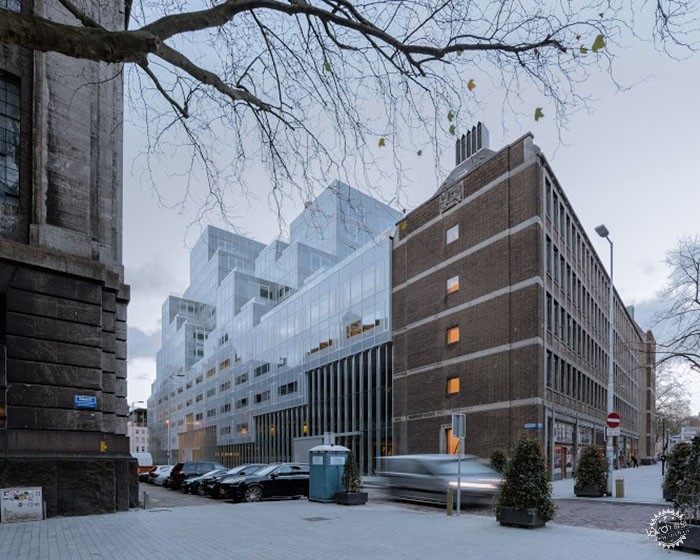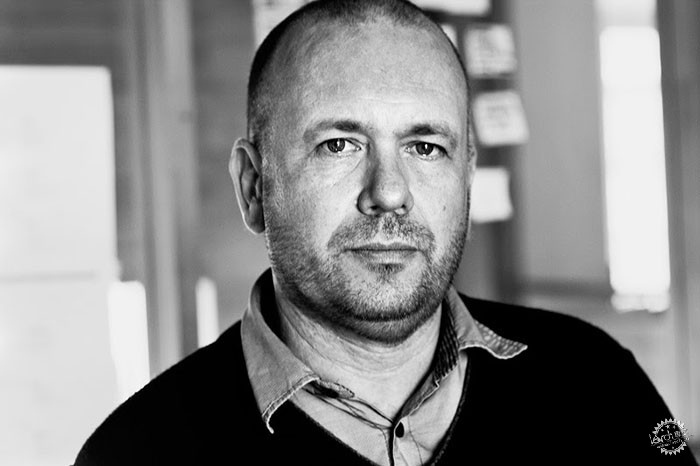Reinier de Graaf Interview on Timmerhuis for Heijmans
2014年9月
September 2014

Photograph by Sebastian van Damme, Courtesy of OMA

Photograph by Ekaterina Izmestieva, Courtesy of Strelka Institute
你认为鹿特丹未来会如何?
鹿特丹很好的一点,是你其实永远不能说准未来的走向。每当鹿特丹似乎满怀热忱朝着一个方向发展时﹐总在十多年后便停下脚步,然后怀着同样的热忱朝另一个方向发展。二战后多种建筑及城市设计的“潮流”在鹿特丹相继冒起,包括战后重建的现代主义、七十年代的人文主义、八十年代的后现代主义、九十年代的高层建筑和高密度城市,以及新千年的“自由开放”风格;它们之间的碰撞形成了今天的鹿特丹。我们无法预测鹿特丹的未来,因此让人兴奋无比。事实上﹐鹿特丹永远都不会是完整的。
Timmerhuis如何融入这种环境?
鹿特特原本已经由多种建筑风格构成,Timmerhuis并不期望又再为其增添多一种建筑风格,反而像是“向混乱投降”(这里我用上“混乱”一词其实是褒义),像是一种代表鹿特丹现状(甚或其未来)的一堆未成形的构筑物。Timmerhuis的建筑形态呼应鹿特丹市貌及其氛围。
对OMA而言这又意味着什么?
Timmerhuis很符合综合用途类建筑(多功能建筑)的传统,例如近期竣工、同样由OMA设计的De Rotterdam。基本上,这次我们致力为住宅带来大不同:同样的高密度、同样的高楼,却让住户有种并非栖身住宅单位的感觉。配有屋顶平台的公寓让人产生错觉,像是在市中心楼高十二层的地方拥有一间配有花园的房子。对于鹿特丹的住宅大厦来说,这真的是个很新颖的概念:多年的四面墙公寓和封闭式户外空间,今天像是变得人性化。
你和鹿特丹有什么关系?
我在离鹿特丹不远的斯希丹出生,斯希丹与鹿特丹在同一区﹐都是在Rijnmond区。正因如此,我很了解鹿特丹。小时候,父母会带我到鹿特丹的电影院(当时鹿特丹还只有些小型的独立电影院)和动物园,我见证着这个城市随年月的变迁:密度变得更高,城市更具活力、更文化(多元)。在我小时候Weena区还是个空地,但你看看它现在的样子... 我见证着一些现在称为(或应为)历史建筑的大楼的兴建,也见证着一些建设的消失,如旧中央火车站和贯通整个城市的高架铁路,而很不可思议地我对这些建筑都很有情感。
如果你就Timmerhuis项目作演讲,你会谈些什么、展示些什么?又或是会让听众体验什么?
我很少就个别项目作演讲,一般会以更广的社会或文化层面来谈我们的项目。所以﹐我会选择就鹿特丹作演讲,而Timmerhuis可以在其中扮演着一定的角色。如果我要谈Timmerhuis,我会讲述大楼的起源和开发过程:我们如何胜出设计竞赛、业主组合如何特别(由鹿特丹市政府和承包商Heijmans组成)。我不会试图用言语形容大楼最终的效果,原因很简单﹐因为Timmerhuis就在附近﹐所有人都可以亲身去看、去体验,对这座大楼能有各自的想法。我相信大楼会引起许多回响,所以在这层面上Timmerhuis也是与鹿特丹市一样的,现在只是等人们为其取个典型的鹿特丹式外号而已。
What future do you see for Rotterdam?
The great thing about Rotterdam is that you can actually never tell where things are going. Each time Rotterdam seems enthusiastically to head into one direction, it only abandons that path a decade later with the same enthusiasm. Rotterdam is a collision of all the architectural and urban ‘en vogues’ that have emerged since the Second World War: the modernism of the postwar reconstruction; the humanism of the seventies; the postmodernism of the eighties; high-rise buildings and the compact city in the nineties and a sort of free-for-all in the new millennium. The future of Rotterdam is unforeseeable and therefore exciting. Actually, Rotterdam will never be completed.
How does the Timmerhuis fit in?
The Timmerhuis does not aim to add a new architectural style to the existing medley of styles, but is actually a sort of ‘surrender to the chaos’, (I am using the word chaos here positively), a sort of unformed heap which is a representation of the city in its current (and probably also future) state. The building is an echo of the city and its mood.
What does it mean for OMA?
The Timmerhuis fits well in the tradition of mixed-use buildings (buildings with multiple functions) such as the recently completed De Rotterdam, also from OMA. This time we have primarily made an effort to do something special with the housing: high-rise, high density, but without giving the residents the feeling that they are living in a flat. The roof terraces create a sense of having a house with a garden, in the middle of the city on the twelfth floor. This is really something new for residential building in the Netherlands: a sort of humanization after years of flat facades and concealed outdoor spaces.
What is your connection with Rotterdam?
I come from the vicinity of Rotterdam, was born in Schiedam, a city in the same agglomeration, in the Rijnmond area. As such I know Rotterdam well. As a child I visited the cinema here with my parents (at that time, there were still just small independent cinemas) and Diergaarde Blijdorp. I have seen the city change through the years: denser, livelier, more (multi)cultural. When I was little, the Weena was still an empty area, and take a look there now… I have seen things under construction which now have (or deserve) the status of monument, as well as things disappear such as the old central train station and the railway viaduct through the city, to which I was strangely attached.
What would you tell / show or let your audience experience if you would give a lecture on the Timmerhuis project?
I rarely give lectures about buildings in themselves. I just talk about our projects in a broader societal or cultural context. So I would rather give a lecture about Rotterdam, in which the Timmerhuis could play a modest role. If I would talk about the Timmerhuis, I would narrate the origins of the building and the process: the winning of the competition, the unusual client constellation in which the commission was shared between the municipality of Rotterdam and the contractor Heijmans. I would not try to capture in words the building in its final state, simply because the building is around the corner and everyone can go and see it with his or her own eyes. Everyone can form an opinion for themselves. I am convinced the building will evoke many comments. Also in this respect the building will be an echo of the city. And now it’s simply waiting to get a typical Rotterdam nickname.
来源:本文由OMA提供稿件,所有著作权归属OMA所有。
|
|
专于设计,筑就未来
无论您身在何方;无论您作品规模大小;无论您是否已在设计等相关领域小有名气;无论您是否已成功求学、步入职业设计师队伍;只要你有想法、有创意、有能力,专筑网都愿为您提供一个展示自己的舞台
投稿邮箱:submit@iarch.cn 如何向专筑投稿?
